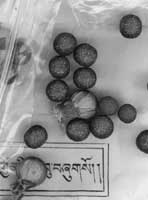|
|
||||
|
A soft therapeutic system connecting mind and body |
||||
|
by Carmen Robustelli To what do we owe the increasing interest in natural medicine, and that connected to non-western cultural traditions? Probably to a more or less conscious wish to improve ones own state of psycho-physical health by means of non-aggressive therapies which offer the chance of increased awareness and active participation in solving the actual illness, not merely its symptoms: we look for a more complete method, possibly the most natural. Together with the physical energy, our wish is to give equal importance to other levels of energy: vital, psychic as well as the cosmic elemental energies, which inter react in determining our state of health. Traditional Tibetan medicine is in line with this need. In fact, Tibetan doctors even consider some mental habits, negative emotional tensions and incorrect ethical actions damaging. For example: according to Tibetan medicine joint problems such as crippling arthritis, are directly connected to an introverse and repressed state: the rigidity of articulations reflects the mental and emotional attitudes of those who complain of such disturbances. Let us begin a short journey across over 2000 years of Tibetan medicine history. We shall notice that already centuries ago healing techniques that in the west are being discovered only this century were perfectly known and used. Today we know them as cromotherapy, music therapy, autogenous training, yoga, prana therapy, acupuncture. The history of Tibetan medicine goes back to over 2500 years ago, before Buddhism manifested in Tibet. The local medical tradition, linked to the Bon philosophical system then flourishing in the country, was based on herbal and mineral based treatments prepared locally. In the VIIth century, King Songtsen Ganpo introduced the first writing system to translate the various Sanskrit texts and world Buddhist languages. He gathered Indian, Nepalese, Chinese and Persian physicians at his court in order to compose a collective new medical treatise, in The Fearless Weapon, the first text on Tibetan medicine. In the VIIIth century, with the spreading of Buddhism in Tibet, Vairochana, the first great Tibetan translator, translated the Four Tantras (Gyu-Shi), a base text of the Buddhist medical tradition, which goes back to the teachings of the historical Buddha, Siddharta Gautauma, also called Shakyamuni Buddha, born in 566 A.C. During the XIth century, the physician Yutok Yonten Gonpo the Elder, revised the Gyu-Shi, rewriting it in the form of study treatise and synthesising the essential principals of the most noted medical systems of the time: from the Indian system of Ayurveda derived the philosophy of the science of healing, that is the dynamics of the three humors (wind, bile and phlegm), as well as the pharmacological techniques; from the Chinese system, came the theory of the five elements and moxabustion; from the Greek system came anatomy and surgery. The method of urine analysis, pulse reading, herbalism and the cure for altitude sicknesses on the other hand, derived from the Tibetan medical system. From the Vajrayana Buddhist tradition derived the aspects concerned with the study of energy “channels”, “winds” and “chakras” (the energy centres in the body). In 1696, Desi Sangye Gyatso, Prime Minister of the Vth Dalai Lama - (in Tibetan Buddhism the Dalai Lama is the supreme religious head as well as the political head) - inaugurated Chakpori, the first monastic school of medicine opened in Lhasa, the capital of Tibet. In order to attend the monks, after following fourteen years of study which included expeditions to gather medicinal plants, had to pass severe admission examinations. In 1916, the XIIIth Dalai Lama and the doctor lama Kenrab Norbu, founded the second medical institute in Lhasa, the Men Tse Khang, which is still operating at university level, and is also open to lay people. Today the most active Tibetan medical centre is situated in Dharamsala, North India, seat of the present Dalai Lama in exile following the Chinese occupation of Tibet in 1959: it is the main centre for the production of Tibetan medicines and houses a school for the formation of young doctors. |
||||
|
|
||||


